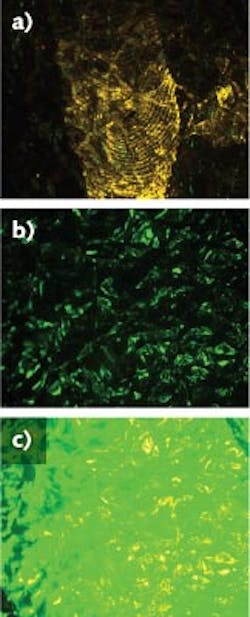FINGERPRINT DETECTION: OPSL rises to challenge of U.S. Army forensic work in Afghanistan

While the use of laser-guided ordnance for military use is generally well-publicized, lasers—in the form of green-emitting optically pumped semiconductor lasers (OPSLs)—have also proven their military value as light sources for forensic work. This work is performed at crime/terror sites and mobile labs in Afghanistan, as well as in military labs in the U.S. In both cases, the lasers are used mainly to find latent fingerprints and to reveal other trace evidence, such as biological fluids.
Chere S. Reynolds is a former civilian military contract employee (a latent-print-processing technician) who recently completed three deployments to Afghanistan as a LP Processing Tech. She explains, “The forensic work we do supports both a criminal mission and an intelligence mission for the Army. In the case of intelligence activities, we want to determine who handled guns or improvised-explosive-device (IED) components, either in captured caches (pre-blast) or after use (post-blast). For the military police work, we need to know who handled a gun or grenade used at a crime scene, such as a rogue shooting, as well as determining the human provenance of forged documents and even counterfeit currency.”
To spearhead this work, the Army now has almost 20 green-emitting lasers produced by Coherent (Santa Clara, CA) and supplied to the military by specialty crime-scene distributor Arrowhead Forensics (Lenexa, KS), according to Brad Brown of Arrowhead. Specifically designed for forensics, the Coherent “TracER” lasers are small, rugged, and, according to Coherent, widely used throughout the U.S. by state and federal law enforcement groups.
Two versions of the laser, emitting 8 and 6 W, incorporate a self-contained battery pack for field portability, while a 4 W version intended for laboratory use is tethered to a 110 V supply. “The battery pack has the added advantage of making the laser immune to interruptions and large spikes in the local Afghan grid,” notes Brown.
The military’s effort in Afghanistan is now winding down as local forces take responsibility for both military and civilian security matters. But, at its peak, Reynolds notes that the workload was huge and depended on “24/7” operation.
Switch from filtered lamp to laser
“Most IEDs incorporate a lot of adhesive tape,” she says. “For some cases, our lab often would have to process over 1000 pieces of tape, looking for latent prints on both the adhesive and nonadhesive side. Yet, sometimes we’d be allocated as little as 48 hours per case. We’d first perform an inherent exam of the tape or other evidence; that is, without using any chemical treatment to develop and reveal latent prints. We’d then most commonly do a standard dye and laser exam as used in most forensic labs in the U.S.; the tape is exposed to ethyl or methyl cyanoacrylate (best known as Super Glue) fumes that preferentially bind to the lipids and other trace organics and inorganics in a print. The surface is then exposed to the highly fluorescent Rhodamine 6G dye, which sticks to the Super Glue. During my first deployment in 2011, we switched from illuminating the dye using a simple filtered lamp, called an alternative light source (ALS), to using the green laser. The number and quality of prints we obtained shot up dramatically with laser excitation (see figure).”
She also notes that the main challenges to lab equipment were the heavy duty cycle demanded by the caseload, the ubiquitous dust in the Afghan air, large temperature swings, and somewhat surprisingly, vibrations. The mobile labs are pods based on standard 40 ft “conex” transshipment containers, with bump-out sides. The outdoor temperature can vary from well below freezing to more than 120°F.
“The lab heaters are hard to control and the lab temperature could drop down below 40°F and then surge to the 80° to 90°F range,” says Reynolds. “And because one of our labs was on a second story, the nearby landing and take-off of fighter jets caused major vibrational issues. Plus, the portable lasers were often subject to relatively rough handling by personnel.” She notes that, even so, they never had a laser head shift out of optimum alignment or fail.

John Wallace | Senior Technical Editor (1998-2022)
John Wallace was with Laser Focus World for nearly 25 years, retiring in late June 2022. He obtained a bachelor's degree in mechanical engineering and physics at Rutgers University and a master's in optical engineering at the University of Rochester. Before becoming an editor, John worked as an engineer at RCA, Exxon, Eastman Kodak, and GCA Corporation.